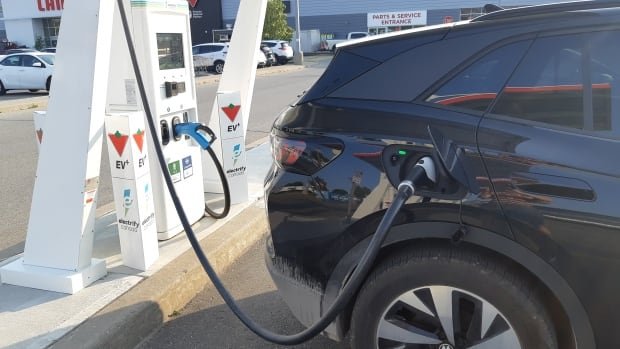My EV gave me freedom from the pumps, but took away my freedom to roam
Caroline Fric planned the route of her 15,000-kilometre road trip around the location of fast-charging stations, similar to this Electrify Canada station at a Markham, Ont., Canadian Tire, to keep her Volkswagen ID.4 electric vehicle running. (Caroline Fric)This is a First Person column by Caroline Fric, who lives in Toronto. For more information about CBC's First Person stories, see the FAQ.I have always loved road trips. It started in my childhood when every so often my dad would arrive home from work early on a Friday afternoon and holler up the stairs to my mom, "Pack up the car, Marsha! Let's get out of town!" My sister and I would be thrilled for the unexpected adventure, heading out from our home in Victoria to wherever was appealing — Washington state, the British Columbia Interior, the Rockies.In the spring, I purchased a new electric Volkswagen ID.4, which has a range of more than 400 kilometres on a full charge, and thought this was the perfect opportunity for a road trip ba


This is a First Person column by Caroline Fric, who lives in Toronto. For more information about CBC's First Person stories, see the FAQ.
I have always loved road trips. It started in my childhood when every so often my dad would arrive home from work early on a Friday afternoon and holler up the stairs to my mom, "Pack up the car, Marsha! Let's get out of town!"
My sister and I would be thrilled for the unexpected adventure, heading out from our home in Victoria to wherever was appealing — Washington state, the British Columbia Interior, the Rockies.
In the spring, I purchased a new electric Volkswagen ID.4, which has a range of more than 400 kilometres on a full charge, and thought this was the perfect opportunity for a road trip back to B.C. to move the rest of my belongings to Ontario.
From my home in Toronto, I decided on a 15,000-km route. I would more or less follow the historic Route 66 to California, staying in old motels with neon signs and taking in the Americana along the way. From Los Angeles, I would head up the coast to Vancouver Island, taking frequent stops to watch waves crash into picture-perfect rocky coves. Coming home, I would meander through B.C. before making my way back through Canada.
Station identification
Once you own an EV, you are immediately preoccupied with understanding where your next charge will come from. Planning the route required research to ensure there were suitable chargers along the way.
All charging stations are not created equal and, because I intended to cover so much ground, I focused on the fastest ones. I didn't want to spend more than an hour at each refuelling stop during the day; a slower charge was fine when I stopped for the night.

Despite my diligence, I realized almost immediately this trip would not go as I had hoped.
The fast charger in Newport, Mich. — my first planned charge after crossing the border — was not operational despite a review on the PlugShare mobile app saying it had worked days before. I had just enough charge to get to the next fast charger, 135 kilometres away.
Most new EV owners go through a period of "range anxiety," or fear that their charge may not be sufficient to get to the next station. I found myself suffering from a new affliction — "charger anxiety." Even when I was certain to arrive at my next charging station, I couldn't be sure it would work.
Once I got into the mountains of Arizona, the scenery became more spectacular, the charging stations more widely available and I felt empowered to explore further off the beaten path. During my travels through Nevada, California and north to B.C., I could finally relax and enjoy the trip.

Fretting about fuel
On the trip home, that sense of freedom vanished as the Rocky Mountains faded into rolling grasslands and chargers became few and far between.
Covering longer distances meant I was often dependent on a single, small-town charger being operational. If it wasn't, I could spend hours — even an entire day — charging at whatever three-pronged outlet I could find.
On occasion that meant cutting the day short and spending the afternoon and night at a campground with electric service. These delays became a relaxing break — and a chance to meet new people and see places like western Oklahoma and Terrace Bay, Ont., where I hadn't planned to stop.
Other times, it meant wandering the cultural void of busy roadways near car dealerships, searching for moderate-speed chargers and feeling envious of motorists going about their business with no concern for how they will refuel.
Being self-employed and able to work remotely meant I didn't have a strict schedule for my trip, but it made me think that most people can't afford to add a day to their journey just to refuel.

With daily reminders that public charging stations often fail, I was reluctant to venture away from my planned route. I had hoped my return trip could stop at national and provincial parks well off the Trans-Canada, but I didn't have the nerve to risk it. So I stuck to the major cities with multiple options — and crossed my fingers in between.
Besides, the delays caused by out-of-service chargers were going to eat away all of my extra travel days.
I love my EV — the driving experience is so much fun and the features are great — and I am happy to do the work to plan my trips. But it has also fundamentally changed my perception of car ownership.
I used to relish the freedom to pick up, grab some gear and head wherever my heart desired. Now, I feel like the car is in charge and I can only go where charging stations allow it. Taking a road trip now is a research project before any bags are packed, and then many prayers along the way.
For my next great adventure, I will strongly consider catching a fossil-fuelled ride with a friend.
Do you have a compelling personal story that can bring understanding or help others? We want to hear from you. Here's more info on how to pitch to us.
What's Your Reaction?

















